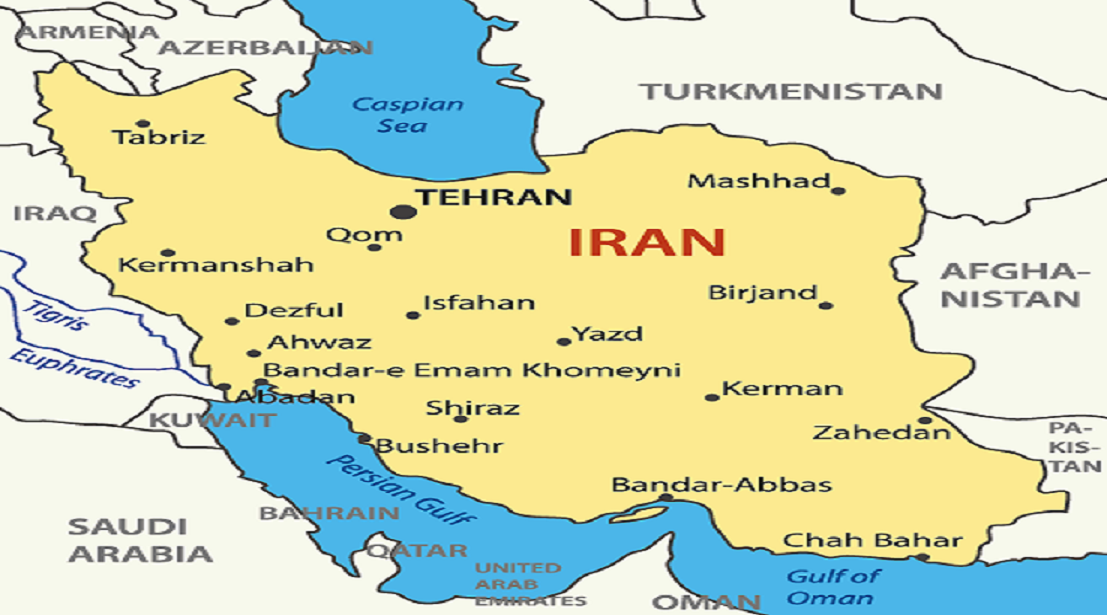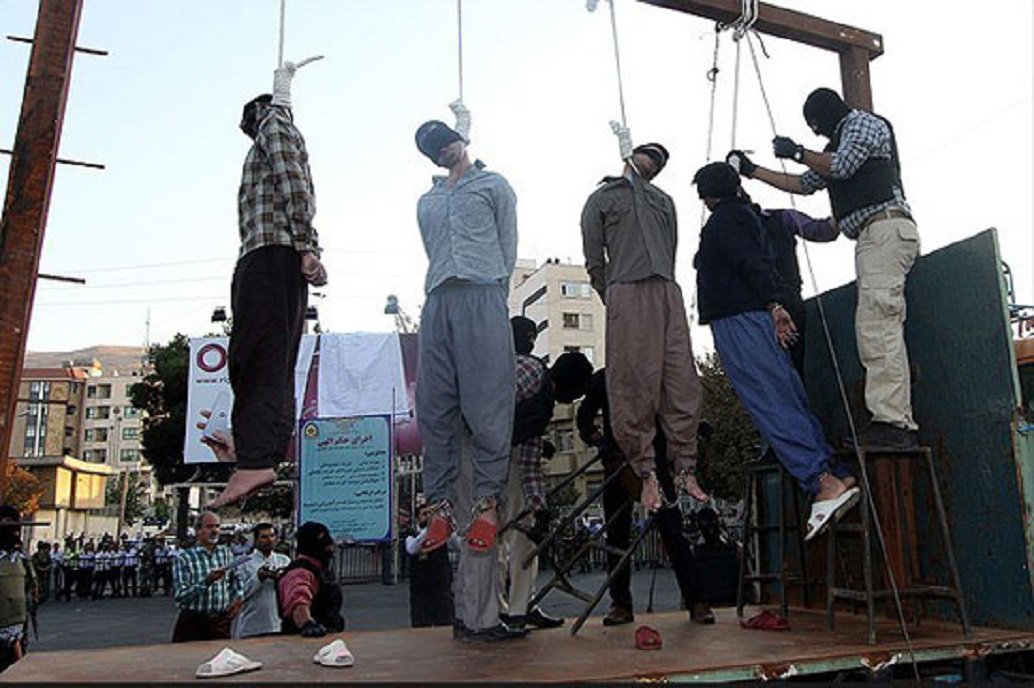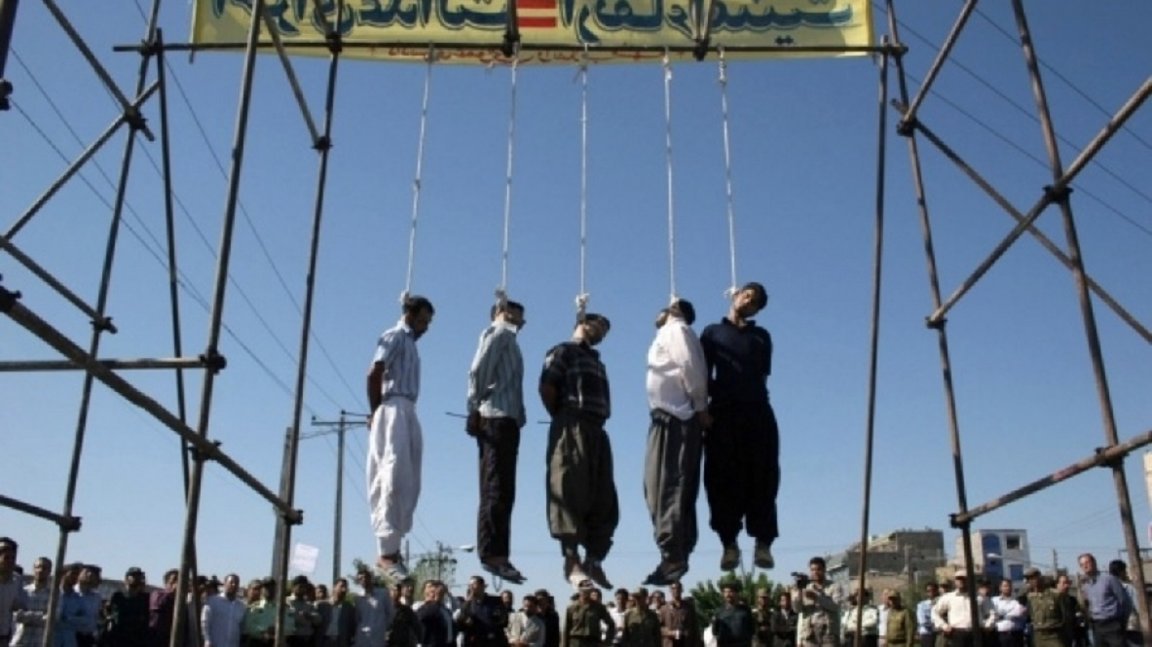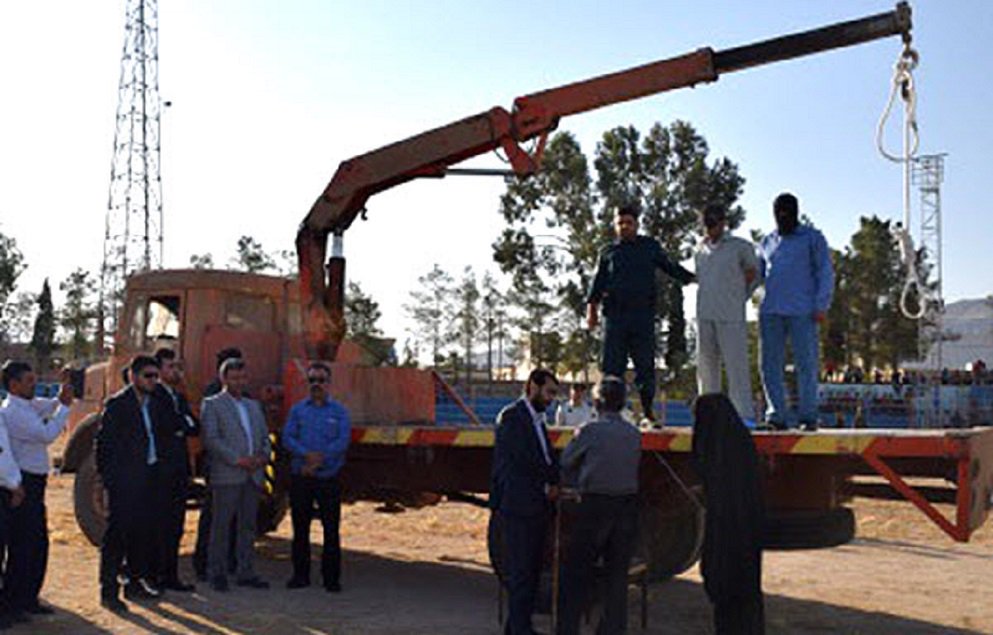IRANIAN REGIME EXECUTED YOUNG AL AHWAZI ARABS,AND THE CRIMES AGAINST THEM.AHWAZI ARABS ARE AN ARAB NATIONALIST AND SEPARATIST WHOSE GOAL IS TO ESTABLISH AN INDEPENDENT STATE CALLED AHVAZ IN IRAN.
 Since the Persian army entered Muhammarah City in 1925 in a bid to
remove the Al-Kaabi state and consolidate Iran's control on Ahwaz,
Iranian authorities have been pursuing a systematic policy to wipe out
the Arab identity of the Ahwazi Arab people. This policy includes
changing the demographics of the region by bringing in non-Arab people
and changing the Arab names of cities, towns and rivers, forcing Arab
Ahwazis out of the region through oppressive security measures and
continuous crack down on Ahwazi activists, and even buying the loyalty
of some Arab tribal leaders.
Since the Persian army entered Muhammarah City in 1925 in a bid to
remove the Al-Kaabi state and consolidate Iran's control on Ahwaz,
Iranian authorities have been pursuing a systematic policy to wipe out
the Arab identity of the Ahwazi Arab people. This policy includes
changing the demographics of the region by bringing in non-Arab people
and changing the Arab names of cities, towns and rivers, forcing Arab
Ahwazis out of the region through oppressive security measures and
continuous crack down on Ahwazi activists, and even buying the loyalty
of some Arab tribal leaders.
In
1925, the British had control of Ahwaz, known then as Arabistan renamed
by Iran as Khuzestan after the colonialists bartered the Arab fertile
land for interest in the rich oil and gas fields. Ahwaz, thirty-two
times the size of Lebanon, had a population of 10 million made up of
mostly Arab Sunnis and Shia with Christians, Kurds, Turkish Azeris,
Turkmen and Baluchis minorities. Ninety years of Iranian oppression,
murder, confiscating land and property, and building settlements for
Farsi families have reduced the Ahwazi population to a half.Al-Ahwaz
region of Iran is currently witnessing a wave of mass protests and
demonstrations demanding freedom and an end to the Iranian regime’s
multifaceted oppression of the Ahwazi people, which has been continuous
since Iran first occupied the region by the use of military force.Ahwazi
Arabs are among the most brutally oppressed peoples in the Middle East.
The population of the region in the south and southwest of Iran totals
around 10 million, with the people united by race, culture and language.
The Ahwazi Arab dialect strongly resembles the dialect in neighboring
Iraq. The majority of Ahwazis are Shia and Sunni Muslim, although there
are other sects and creeds, including Christian and Mandaean.Ahwaz
is a Persian-occupied Arab country located in the north and the east of
the Arabian Gulf to the east of Shat Al-Arab waterway which has been
occupied by Iran for more than eight decades and renamed ‘Khuzestan.’The
entire territory of Ahwaz, covering 324,000 square kilometers, is
bounded to the west by Iraq, to the south-west by the Arabian Gulf and
Arabian Peninsula and to the north, east and south-east by the Zagros
Mountains, the natural boundary between Ahwaz and Iran. With an Arab
population of ten million, Ahwaz is among the most resource-rich
territories occupied by Iran, holding more than 80 percent of the
country’s oil and gas resources.The region has three major rivers, the
Karoon, Jarrahi and Karkheh, which play a vital role in the lives of its
people, with most Ahwazis long economically dependent on the three
waterways for their income from both fishing and agriculture, with the
waters used to irrigate the rich arable land.Historically the Semitic
Elami tribes, the first known peoples of the Arabian Peninsula and Iraq,
settled on Ahwaz’s riverbanks and valleys, establishing a great
civilization, particularly the ancient city of Susa, now known as Shush.Since
the initial annexation of Ahwaz by Iran, then known as Persia, 90 years
ago, the humanitarian situation of the Ahwazi Arab people has steadily
worsened, with the level of murderous repression by the current regime
rising daily, extending to the level of systemic ethnic cleansing as
policy, forcible eviction of the Ahwazi indigenous people, and the
construction of exclusive apartheid-style settlements for non- Ahwazi,
non-Arab settlers; these settlers are offered multiple economic and
social incentives to move there and given guarantees of a promising
future, while the Ahwazi Arab indigenous peoples are further
marginalised, alienated and denied the most basic rights in every
field.Historically the catastrophic suffering of the Ahwazi people first
began after Reza Khan, the then-ruler of Persia, now called Iran, and
invaded the Emirate of Al-Ahwaz in 1925, overthrowing the last
independent Arab ruler of the region, Sheikh Khazaal Alkaabi, who was
subsequently imprisoned in Tehran for 10 years before being murdered in
1936 by strangulation on the orders of Reza Khan.The
current theocratic Iranian regime has imposed authoritarian rule on
Al-Ahwaz region by the harshest measures, in a bid to isolate the Ahwazi
Arab people from their origins and their historical association with
the Arab nations, simultaneously imposing an absolute media blackout on
any reporting of the suffering of Ahwazis.As is widely known, the
Iranian regime provides no official statistics on the number of Ahwazi
Arabs in Iran, but studies conducted by Ahwazi activists confirm that
the current total Ahwazi population stands at between 8 and 10 million.
American historian William Theodore Strunk in his work about Ahwaz: The
Reign of Sheikh Khazal ibn Jabir and the Suppression of the Principality
of Arabistan.


 Ahwazi Community in the UK demonstrated against the persecution of the Arabs by the
Iranian regime. Following the protest a group of Ahwazi activists.Abdulrahman Al-Ahwazi, from
the Patriotic Arab Democratic Movement in Al-Ahwaz, highlighted the
environmental crisis in the region which caused by building water dams
in the area of Al-ahwaz (Khuzestan). Al-Ahwazi stated that climate in
the province of Al-ahwaz is dependent on the main rivers such Karoun,
Karkheh and Jarrahi. The Iranian authority built more than 40 water
dams, and 36 are under construction while 176 are planned to be built in
future. Consequently, these dams led to dry international marshlands
such Fallahiya and Hur-alazim and disruption of biodiversity.
Ahwazi Community in the UK demonstrated against the persecution of the Arabs by the
Iranian regime. Following the protest a group of Ahwazi activists.Abdulrahman Al-Ahwazi, from
the Patriotic Arab Democratic Movement in Al-Ahwaz, highlighted the
environmental crisis in the region which caused by building water dams
in the area of Al-ahwaz (Khuzestan). Al-Ahwazi stated that climate in
the province of Al-ahwaz is dependent on the main rivers such Karoun,
Karkheh and Jarrahi. The Iranian authority built more than 40 water
dams, and 36 are under construction while 176 are planned to be built in
future. Consequently, these dams led to dry international marshlands
such Fallahiya and Hur-alazim and disruption of biodiversity.
Iran
was the first to exercise gruesome apartheid. White Rulers (British
descents) of South Africa rushed to the new found oppression college and
enrolled thousands of potential terrorists and military personal. The
Zionist Organization also had studiedapartheid
curriculum in Iran, graduating with high grades and cloned the
repressive college and established branches in Israel. Iran’s psychopath
deans established institutions In Iraq, Syria, Yemen, Lebanon and other
Gulf and North Africa countries. No one should wonder anymore which is
the biggest terrorist state in the world. Since Khomeini’s 1979
Revolution, Iran has exercised the worse apartheid practices with
intentions never to stop. Ahwaz territories hold 80% of Iran’s oil and
gas;to the west of which is Iraq, and to the south-west is the Arabian
Gulf and Arabian Peninsula; the Zagros Mountains to the north, east and
south-east sit between Iran and the Arab territories. Ahwaz wealth
didn’t just stop at oil and gas. It has the rich arable land; three
major rivers, the Karoon, Jarrahi and Karkheh played a vital role in the
livelihood of the people, provided agriculturally and fishing revenues
until the apartheid regime redirected the three rivers to Iran’s
territories. Only one percent of the oil and gas revenues returned to
the indigents.Iran’s Mullahs blocked all possible world connection and
communication with Ahwaz territories to mask the daily murderous
repression. The ethnic cleansing policy routinely exercised by settlers,
mullahs and soldiers; forcible eviction and bulldozing homes and
properties go on like an endless marathon. The indigents live without
clean water; electricity and food are scarce; most of them live in tents
and water mains. World human rights and humanitarian organizations have
said little and did little to expose the war crimes and crimes against
humanity committed for 90 years and counting. The Arab neighbors of the
same skin and language also have done little.If we compare Israel’s
apartheid against Iran’s using skin burn gauge, the Israeli repression
measures one degree; Iran’s gruesome repression means third
degree.Historically, Ahwazis belong to Elami Arab tribes who settled in
these vast Arab territories four thousands of years and established a
high civilization in the ancient city Susa, now known Shush. In 639,
Iran came under the Muslim Rule. Ahwaz changed hands between Arabs and
Persians multiple times from the 15th century to the second half of the
nineteen century.Pre-Islamic Iran’s art, education, literature, poetry
and philosophy stayed at particle progress. Under the Islamic Rule, the
country embraced Arabic language for 200 hundred years, putting the
Farsi language on hold. Iran saw a notable surge of great thinkers,
philosophers, scholars, poets and writers. Most people don’t know that
the works of these great minds were all produced in Arabic and continued
beyond the two hundred years. The present regime in Iran denies these
facts. Their curriculum, media and propaganda mullahs credit Iran for
all Arab progress before and during the Islamic Rule. Iran has gone as
far as forging the principles of Islam, classifying all Arabs and Sunnis
infidels. Ancient Persia incubated hatred and venom against Arabs; the
Romans carried the great terror for centuries; then the West expanded
wars to reach the region and are still doing it. Zionism is the latest
by-product that had nurtured and raised traitors like Assad family, the
Iraqi and Houthi Mullahs; it also nurtured and raised Sunni, Shia and
Christian collaborators. These traitors remain far worse than land
mines.The region where the
Ahwazi Arab community is most present in Iran has been troubled by a
deep economic crisis that has hindered its indigenous Arab population
from securing its most basic needs.Until a century ago, Arab Ahwaz was a
primarily autonomous region in Iran until the Pahlavi monarchy took
over and made an effort to end ethnic autonomy across Iran in 1925. The
Ahwaz region is responsible for some of Iran's biggest oil and gas
fields, and some of the most nourishing and arable lands for Iran's
agricultural industry. Despite these valuable resources, the region's
economy continues to struggle, and the indigenous population see little
of the rewards of this wealth. They are often the victims of untreated
illness, hunger and deprivation.The Iranian regime systematically denies
Ahwazi Arabs jobs in the local oil, gas and petrochemical industries.
The government has also constructed a multitude of dams diverting water
from Arab areas to Persian areas such as the Isfahan, Yazd, Kerman, and
Qom provinces. These dams have only served to worsen the devastation
from a drought currently plaguing the region, destroying the local
agriculture, fishing, and palm industries.The unemployment rate among
the Ahwazi Arab youth has now risen to 81%. Iran's general director of
cooperatives, work, and social welfare, stated that 5% of Ahwazis
looking for jobs have pre-high school education, 55% of those seeking
work only completed secondary school, and 45% of those Ahwazi job
seekers hold university degrees.The
Ahwazi quest for independence remains a source of growing concern for
the Iranian regime because of the ethnic diversity of the country where,
in addition to Arabs, the mosaic includes Persians, Azeris, Kurds and
Baluchs and others. Each of these ethnic groups retain their own
traditions and culture that have extensions beyond the Iranian border.
In addition, several organizations are seeking to restore the national
gains that these ethnic groups lost in different historical eras,
including the Arab national identity of Ahwaz where relevant
organizations run active political arms beyond the control of the
Iranian regime. The activity of these organizations are well-received by
human rights groups interested in championing the causes of minorities
suffering oppression in home countries.Iran's
concern emanates from the fact that raising such issues negatively
impacts the stability of the state, its unity and territorial integrity.
The continuity of the Ahwazi movement and difficulties hindering the
Iranian regime's attempt for suppression will tempt other ethnicities to
follow suit. This is particularly important because the state in Iran
used to praise the "Islamic" revolutionary regime for its stability,
strength and ability to assimilate and accommodate for all the country's
ethnicities, despite the fact that such events and their aftermath
stand in stark contrast with the claims that the Iranian regime is
attempting to promote.This
is being further affirmed by senior Iranian officials. These officials
blame the interference of Iran's foreign enemies for instigating ethnic
strife as part of "conspiracy theory" mantra that the Iranians are good
at promoting whenever they seek to mobilize the support of the crowds
for the regime on the pretext that the state is facing external threats
to its very existence.This
was made clear by a special adviser to Supreme Leader Ayatollah Ali
Khamenei during a press conference on 9 May 2015 in Tehran. Major
General Yahya Rahim Safavi accused "17 regional and trans-regional
intelligence services affiliated to the Arab and western states” of
running operations “in support of ethnic separatist groups to sow
discord among the local people” in the south-western province of
Khuzestan (Ahwaz). The top Iranian military aide expressed his concern
that the ongoing war in Syria and Iraq would spill over to "Khuzestan"
endangering the territorial integrity of Iran. On 2 September 2014, Imam of Ahwaz city, Ahmed Reza Hajati, stressed that 35
intelligence services run operations in the province. The cleric's
claims show how concerned the Iranian regime is about any movement in
this region (Ahwaz), and also show that its concerns are persistent and
not associated with a particular happening.
 After
trials human right activists described as grossly unfair Iran has
executed members of its Ahwazi Arab minority."The Iranian authority
informed their families that they were executed by hanging and in secret
... The AHRO condemns this criminal act against these activists who did
not have fair trial.Ahwazi Arabs in Iran often face state
discrimination in areas including education, employment politics and
culture. In recent years, many members of the community have taken to
the streets to protest at the discrimination against them.
After
trials human right activists described as grossly unfair Iran has
executed members of its Ahwazi Arab minority."The Iranian authority
informed their families that they were executed by hanging and in secret
... The AHRO condemns this criminal act against these activists who did
not have fair trial.Ahwazi Arabs in Iran often face state
discrimination in areas including education, employment politics and
culture. In recent years, many members of the community have taken to
the streets to protest at the discrimination against them.


